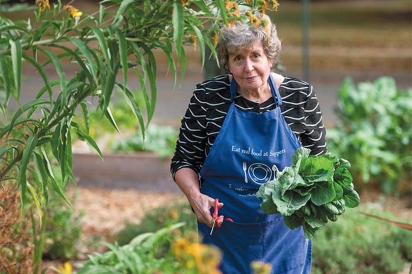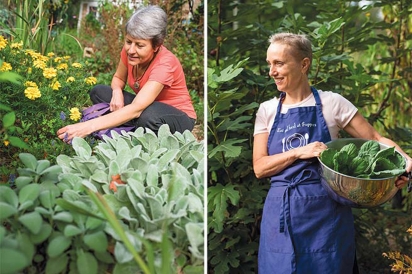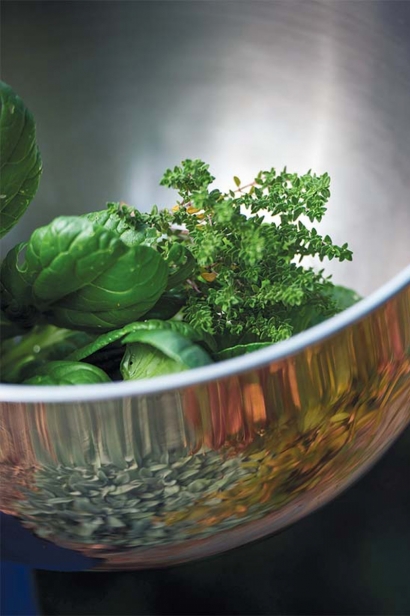The Suppers Programs Reroutes the Road to Healthier Eating
Supper for All
When Cindy Foss talks about the physical and emotional challenges she has faced, it is difficult to reconcile the gravity of her words with the lightness of her demeanor.
So, too, with Bebe Attar. With wide smiles and easy laughter, the women describe years of depression, anxiety, debilitating headaches and physical pain. They speak with deep gratitude of Dorothy Mullen, the woman whose groundbreaking work led them to make the dietary changes that turned all that around. And their stories challenge some food activists’ prescriptions that any one diet or level of cooking skill is essential to improving public health.
Mullen is the powerhouse behind the Suppers Programs—a free (except for the price of ingredients) program that provides safe, friendly settings in which people who are managing food-related health challenges can gather to prepare and share a healthful meal. The organization’s motto—“If you can make a pot of coffee, you can make a pot of soup”—is meant to ease the anxiety that cooking triggers in so many people. But Mullen has found that getting people back in the kitchen takes more than simple recipes and a pithy slogan. It requires a supportive community that welcomes a variety of learning, cooking and eating styles.
A holistic health practitioner, master gardener and former board president of the Foundation for the Advancement of Innovative Medicine, Mullen chose to get a master’s degree in counseling rather than nutrition because she knew that, to help people change their eating habits, she needed to understand the motivations behind their addictive behavior toward food. Foss was Mullen’s first test case for the ideas that would form the core of the Suppers Programs.
She also presented Mullen with a challenge: Cooking is not something that Foss feels driven or able to do. “I have no desire to do it without support,” Foss says. For her, support means learning to cook a new dish with one-on-one guidance on what and how much to buy and step-by-step instruction on how to combine ingredients into a dish. Because she is a single mom to two children, the dish has to be easy to prepare. It also has to fit within the dietary guidelines that she has developed for herself, in part through her engagement with Suppers.
As a member of Alcoholics Anonymous (AA) with more than 22 years sober, Foss is a person who is comfortable working a program— that is, having the path forward laid out in clear steps. This made her a valuable asset to Mullen as she designed the Suppers Programs. In return, Foss learned that foods such as gluten, coffee, dairy and sugar were contributing to her depression and anxiety. By eliminating those foods, she has gone what she described as “25 percent good days, 75 percent anxious and depressed” to 70 percent good days, with the ability to feel when she is “going off the tracks.” To maintain her health and energy, she now basically lives on the recipes for breakfast chili, soups, slaws and stews that Mullen has taught her.
“I had such an ‘aha’ moment out of eating breakfast chili that I copied that exact recipe and I ate that exact recipe every day for about two years,” Foss says. “Because I felt so good on it, I didn’t want to not have it.” She makes substitutions within those recipes, with the help of food lists she has made, to guide her toward choices that are right for her, such as replacing beef with turkey. While she would like to expand the number of dishes that she feels comfortable making, the repetition of eating a small selection of dishes doesn’t bother her at all. Being judged on her food choices, however, does. So, when Mullen began to hold Suppers meetings based on the ideas that she and Foss had worked through, Foss pulled back.
“It kept showing me how different I was,” Foss says: “what I didn’t like, what I wasn’t good at, what I didn’t want to do.” In those early meetings it became clear to Mullen, too, that people become defensive or withdrawn when others make pronouncements about what is healthy, ethical or delicious. “That judgment thing—that was my first really huge inconvenient truth,” Mullen says. “If you don’t focus on non-judgment, you can’t have people with all these different opinions and preferences around food in the same room together.” She had to go back and incorporate non-judgment as a central aspect in the program’s design.
Still, for Foss, who describes herself as highly sensitive and emotional, it was only the formation of a Suppers group devoted to those in recovery that brought her back to the Suppers table. “I think being in that like-minded place, knowing what other AAers have been through, on some level, creates more safety for me.” Part of that AA experience is knowing how to speak about one’s own experience, strength and hope while refraining from judging or giving advice about the experiences of others. For Foss, it means a place where she can be open about her dislikes and insecurities around cooking and have it be well received by others.
Mullen is a seat-of-the-pants cook who is at ease in the kitchen. She can simultaneously cook and direct the prep work being done by a kitchen full of Suppers members with varying levels of skill. Mullen never cooks from a recipe, so while some Suppers members are busy chopping ingredients and making salad dressings, others shadow her in the kitchen, writing down each step and addition. If members deem a dish tasty, the recipe gets posted on the Suppers website, which has a searchable database of over 700 simple-to-prepare recipes.
This can be a difficult learning environment for inexperienced cooks like Foss, who need more structure, a step-by-step approach and a feeling of safety around asking very basic cooking questions. For those who are new to the program, it can be overwhelming at first to figure out how to join in the cooking portion of the meetings. Because health concerns are what brings most people into a Suppers meeting, Mullen has found that their fear and emotion around that health issue has to be addressed before the cooking instruction begins to take hold. “You have to get them past their anxiety,” Mullen says.
“The food has to be delicious enough and the process has to be socially engaging enough that they can actually eat the food that’s going to turn around their diabetes or reduce their need for medications. Then they can relax and start learning how to do food preparation.”
As an accomplished and improvisational cook, Attar has no problem learning from Mullen’s free-flowing style, which she likens to watching a ballet dancer in the kitchen. Through Suppers, Attar has learned tricks to enhance flavor. She has refined the way she uses and combines spices. And she has discovered new vegetables such as collard greens and a wider variety of squash.
“Dor breaks it all down in the prep. She talks as she goes along and says what we’re doing, how we’re going to do it and why we’re doing it that way,” Attar says. “Why do we put the spice in first and not afterward? What does this dish need and when are we going to add the flavoring? When are we going to put the kale into the soup? It’s all broken down.” Attar has observed that, if they are open to learning, even the most hesitant members pick up cooking skills and become more comfortable in the kitchen over time.
While cooking came easily, Attar’s challenge when she first came to Suppers was overcoming her resistance to changing what she cooked— even though she knew that what she was eating was contributing to her health problems, which included rheumatoid arthritis.
Attar figured out which foods were contributing to her inflammation by using the exercises and experiments designed to help Suppers members identify which foods are best for their individual biology. Those exercises and experiments are based on a simple and profound idea—that whether you’re dealing with depression, anxiety, diabetes, learning issues or problems with alcohol, when it comes to food, “how you feel is data.” By tracking how your body responds to the food you eat and experimenting with eliminating suspect foods, you can identify which foods contribute to your individual long term health—as well as short-term energy, mental clarity and relief from pain and other symptoms—and which foods do not.
But, as Attar discovered, knowing which foods you need to eliminate is only half the battle. Even though she believed that she needed to change, the severity of her symptoms was what made her willing to take action. It took sixteen months and the supportive friendships she made through Suppers to turn her diet and health around.
Attar puts her cooking knowledge and her personal experience with how hard it is to change your diet to full use in her role as facilitator of Monroe Seasonal Suppers—a lunchtime Suppers group that meets monthly in her kitchen. The group is mostly composed of seniors who want to have a healthier diet but are either uncertain about or resistant to preparing foods from scratch. She finds that, much like Foss, they have a lot of very basic questions about purchasing and preparing fresh ingredients.
To help them overcome their fear around cooking, Bebe breaks everything down—the buying, the prep, the cooking—into simple, manageable steps. When developing recipes, she focuses on how to get the most flavor in the fewest steps. “When the people come into my kitchen and we prepare it together and we cook, they see how easy it really is,” Attar says. “I really keep it super, super simple. A few ingredients, two or three steps, until it’s on the plate.”
After the meeting, she emails the recipes out to the group, which usually numbers around eight. Her hope is that the combination of hands-on instruction and simple recipes will inspire her members to repeat the recipes at home until they become effortless to make. That way, over time, they will build a repertoire of flavorful seasonal dishes. “The simpler you make it for someone, the more they are apt to do it,” Attar says. “So break it down.”
By forming her own group, through which she shares both her cooking skills and her personal journey, Attar is helping Mullen achieve her dream of expanding Suppers by having experienced members become facilitators of their own groups. It has been harder than Mullen first imagined to find new Suppers facilitators. “It’s much easier to teach a new person the program if they’re already a cook than it is to find a person who knows the Suppers program and teach them how to cook.” Mullen says.
While the pace of change may not yet match Mullen’s hopes, the community she has built is showing that everyone can contribute, in their own way and at their own comfort level, to the wellness of others. “Suppers has opened up new avenues of my life that I never explored before, such as teaching people about food and health,” Attar says. Even Foss, despite her own reluctance to cook, is eager to help friends who want to learn to prepare healthier food by teaching them the dishes she knows in the way Mullen taught her—side by side, step by step. “I do one-on-one mentoring,” she says, “because that’s what came to me.”
Suppers is proving that participating in a nurturing community motivated by personal experiences of how food affects health can lead people to better diets in many diverse ways. It also raises the possibility that, rather than battling over universal, prescriptive diets, we can turn the tide of food-related illnesses by building communities of individuals who support each other in finding their own ideal diet by recognizing that how you feel is data.
The Suppers Programs
thesuppersprograms.org
THE NATURE OF FLAVOR
Chefs and farmers devote a lot of time and energy to raising and preparing flavorful foods. But that, says Mullen, is only half of the flavor equation. The other half has to do with how we each perceive flavor—which may help explain why simply telling people to cook more vegetables isn’t changing the way America eats.
Through her work, Mullen has seen that when a person’s taste buds have been hijacked by repeated exposure to processed foods, that person’s ability to appreciate the flavor of fresh, whole ingredients is greatly diminished. This adds an additional challenge to persuading Suppers members to cook with fresh ingredients: Regardless of the flavor that is inherent in those ingredients, they may not taste flavorful or appealing to members whose palates are used to the amped-up flavor of processed foods. Fortunately, that can be reversed.
When processed foods are removed from the diet and replaced by real foods, those whole, natural foods that once tasted dull and boring slowly begin to taste better and better. “It will happen— it’s a matter of weeks or months,” Mullen says. “It changes from person to person, but your body will reclaim its connection to the taste of real food if you restrict the artificially stimulating stuff. There’s a leap of faith.”
FLAVOR BOMBS AND OTHER TIPS
Dorothy Mullen and her Suppers facilitators have to serve flavorful, balanced dishes with a variety of add-on options in order to appeal to a wide range of tastes and preferences. Here are a few of their crowd-pleasing flavor secrets: The processed-food industry has hit on a winning formula of complexity, textural differences, flavor synergy and visual appeal. Mullen tries to incorporate those same qualities into dishes that use high-quality ingredients. She always has ingredients that add crunch on the table, such as toasted nuts and sprouts. The dressings are bright with citrus and balanced with salt and a touch of sweet. Creaminess is supplied by avocados and coconut milk. And flavor enhancers are always at hand. “We became connoisseurs of hot sauce, vinegars and mustards, inexpensive ingredients that packed a lot of flavor,” Mullen writes in her book The Logical Miracle.
Flavor balancing is an idea that natural-foods chef Allie O’Brien brought to Suppers. Members are encouraged to join in a group tasting of dishes in progress and to contribute their thoughts on what a dish might need, such as balancing the sweet, salty, sour and bitter notes or adding a hit of citrus or salt to brighten a dish that tastes flat.
These “flavor bombs” landed on the Suppers tables in response to the need to satisfy a lot of different flavor preferences at one table. Incorporating ingredients like ginger, plums, citrus and cilantro, “fl avor bombs” add an extra hit of flavor intensity. By having them on the table as an optional add-on, the main dish can be fairly basic to satisfy the taste preferences of those who don’t like too much spice or zing.
ABOUT THE SUPPERS PROGRAMS
A Suppers meeting typically involves a small group of people (eight to ten) gathering at a private home to cook and dine together. Attendees share the cost of the groceries and a onedollar donation is requested to help fund the organization. No highly processed food is allowed, nor are commercial messages or sales pitches for products or services. Sugar is only present in the form of small additions of maple syrup or honey. A Suppers facilitator organizes the menu, shops for the ingredients, orchestrates the cooking and oversees the meeting—managing not just the flow of the meal but also the tenor and tempo of the conversation, which generally focuses on the healthful nature of the meal as well as a chosen health-related topic.













